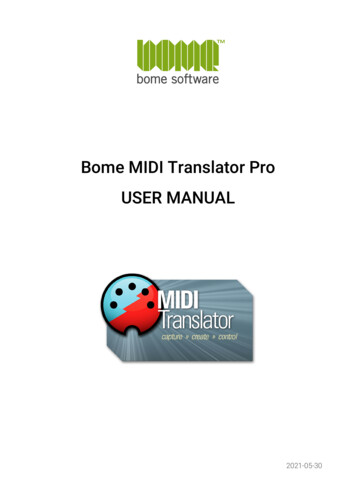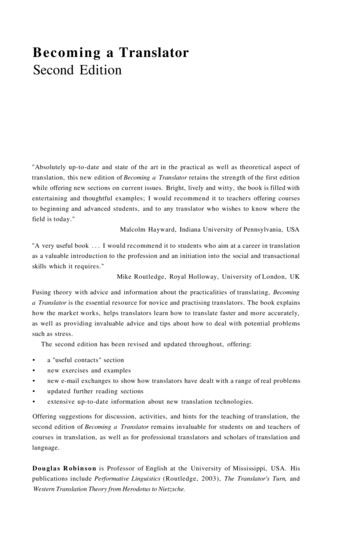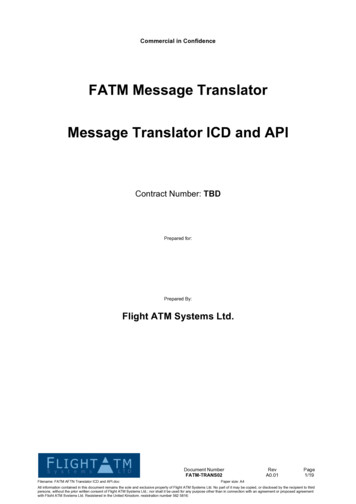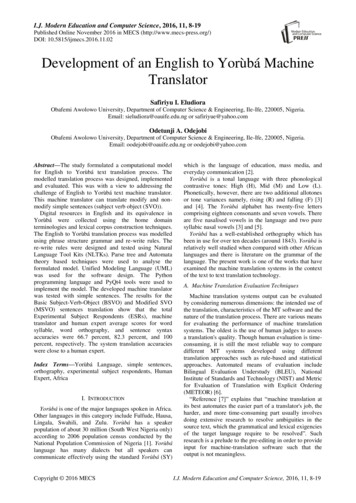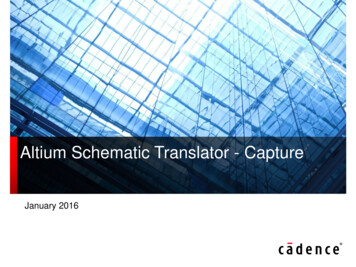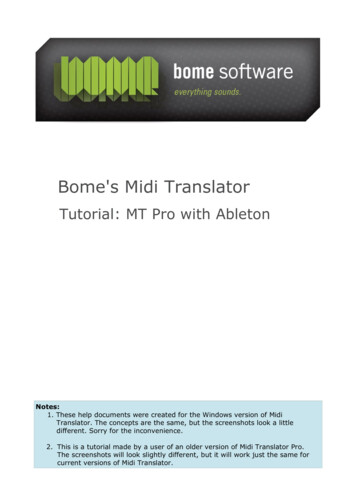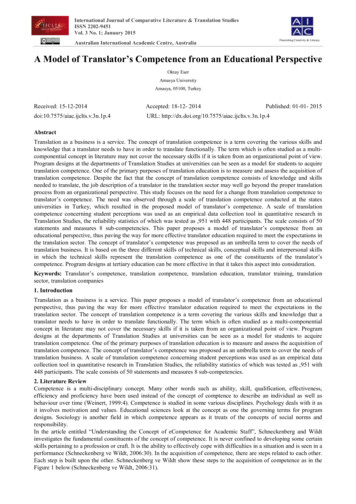
Transcription
International Journal of Comparative Literature & Translation StudiesISSN 2202-9451Vol. 3 No. 1; January 2015Flourishing Creativity & LiteracyAustralian International Academic Centre, AustraliaA Model of Translator’s Competence from an Educational PerspectiveOktay EserAmasya UniversityAmasya, 05100, TurkeyReceived: 15-12-2014Accepted: 18-12- 2014Published: 01-01- 2015doi:10.7575/aiac.ijclts.v.3n.1p.4URL: tractTranslation as a business is a service. The concept of translation competence is a term covering the various skills andknowledge that a translator needs to have in order to translate functionally. The term which is often studied as a multicomponential concept in literature may not cover the necessary skills if it is taken from an organizational point of view.Program designs at the departments of Translation Studies at universities can be seen as a model for students to acquiretranslation competence. One of the primary purposes of translation education is to measure and assess the acquisition oftranslation competence. Despite the fact that the concept of translation competence consists of knowledge and skillsneeded to translate, the job description of a translator in the translation sector may well go beyond the proper translationprocess from an organizational perspective. This study focuses on the need for a change from translation competence totranslator’s competence. The need was observed through a scale of translation competence conducted at the statesuniversities in Turkey, which resulted in the proposed model of translator’s competence. A scale of translationcompetence concerning student perceptions was used as an empirical data collection tool in quantitative research inTranslation Studies, the reliability statistics of which was tested as ,951 with 448 participants. The scale consists of 50statements and measures 8 sub-competencies. This paper proposes a model of translator’s competence from aneducational perspective, thus paving the way for more effective translator education required to meet the expectations inthe translation sector. The concept of translator’s competence was proposed as an umbrella term to cover the needs oftranslation business. It is based on the three different skills of technical skills, conceptual skills and interpersonal skillsin which the technical skills represent the translation competence as one of the constituents of the translator’scompetence. Program designs at tertiary education can be more effective in that it takes this aspect into consideration.Keywords: Translator’s competence, translation competence, translation education, translator training, translationsector, translation companies1. IntroductionTranslation as a business is a service. This paper proposes a model of translator’s competence from an educationalperspective, thus paving the way for more effective translator education required to meet the expectations in thetranslation sector. The concept of translation competence is a term covering the various skills and knowledge that atranslator needs to have in order to translate functionally. The term which is often studied as a multi-componentialconcept in literature may not cover the necessary skills if it is taken from an organizational point of view. Programdesigns at the departments of Translation Studies at universities can be seen as a model for students to acquiretranslation competence. One of the primary purposes of translation education is to measure and assess the acquisition oftranslation competence. The concept of translator’s competence was proposed as an umbrella term to cover the needs oftranslation business. A scale of translation competence concerning student perceptions was used as an empirical datacollection tool in quantitative research in Translation Studies, the reliability statistics of which was tested as ,951 with448 participants. The scale consists of 50 statements and measures 8 sub-competencies.2. Literature ReviewCompetence is a multi-disciplinary concept. Many other words such as ability, skill, qualification, effectiveness,efficiency and proficiency have been used instead of the concept of comptence to describe an individual as well asbehaviour over time (Weinert, 1999:4). Competence is studied in some various disciplines. Psychology deals with it asit involves motivation and values. Educational sciences look at the concept as one the governing terms for programdesigns. Sociology is another field in which competence appears as it treats of the concepts of social norms andresponsibility.In the article entitled “Understanding the Concept of eCompetence for Academic Staff”, Schneckenberg and Wildtinvestigates the fundamental constituents of the concept of competence. It is never confined to developing some certainskills pertaining to a profession or craft. It is the ability to effectively cope with difficulties in a situation and is seen in aperformance (Schneckenberg ve Wildt, 2006:30). In the acquisition of competence, there are steps related to each other.Each step is built upon the other. Schneckenberg ve Wildt show these steps to the acquisition of competence as in theFigure 1 below (Schneckenberg ve Wildt, 2006:31).
5At the beginning is information. Through networking, it turns into knowledge. It is an ability if knowledge is applied ina given situation. When an ability is mixed with attitude consisting of motivation and values, an action is mentioned.Competence is when an action meets the criteria of adequateness to social norms. Professionalisation is the last stepwhere competence comes with responsibility.IJCLTS 3 (1):4-15, 2015ProfessionalisationCompetence wledge ApplicationNetworkingFigure 1. Steps to the Acquisition of CompetenceSource: Schneckenberg ve Wildt, Understanding the Concept of eCompetence for Academic Staff, 2006:31.Another comprehensive study of the concept of Competence is the DeSeCo (Definition and Selection ofCompetencies: Theoratical and Conceptual Foundations) Project initiated in 1997. It aims to define competenceandto determine the basic key-competencies related to the socio-economic environment (DeSeCo, 2001:2). They studyit as an action-oriented concept of cognitive and incognitive constituents. It can’t be free from an action. It is goaloriented and appears in a situation. Therefore, it is social. Rychen defines competence(Rychen, 2003:3):“A competence is defined as the ability to successfully meet complex demands in a particular contextthrough the mobilisation of knowledge, cognitive skills but also practical skills, as well as social andbehaviour components such as attitudes, emotions, and values and motivations.”Competence is a determining factor in drawing up program designs in education. In a learner-centered approach, thereare some dichotomies standing out: Goal- vs. competence-orientedness, behavourism vs. social constructivism, teachingvs. learning, information vs. situaltion (Jonnaert et. al., 2006:13).Competence-oriented program designs have been around for the department of Translation and Interpreting atuniversity. Such concepts as knowledge (PACTE, 2000; Bell, 1991; Tirkkonen-Condit, 1992), skills (Harris andSherwood, 1978; PACTE, 2000), ability (Koller, 1979; Toury, 1984; Bell, 1991), expertise (Kiraly, 2003; Shreve,2002), and proficiency (Wilss, 1992; Cao, 1996; Malmkjaer, 2008) define the qualities that a translator needs to have inorder to translate texts. These qualities fullfil seperate but complementary needs in the translation competence, which isan umbrella term involving them all. Recent research has shown that translation competence has been evolving frompartial research to holistic and empirical models. The models of translation competence which study the concept as amulti-componential term often divides into two: Models resulting from the needs of translation education and those oftranslation sector.On translation education, there are models of translation competence drawn up by such individual researchers asNeubert (Neubert, 2000:3), Schäffner (Schäffner, 2000:146-148), and Yazıcı (Yazıcı, 2007:139) and research projectslike PACTE (Process in theAcquisition of Translation Competence and Evaluation) carried out at UniversitatAutonomade Barcelona (PACTE, 2003:60) and TransComp at UniversitätGraz (Göpferich, 2009:21). They aim to study andimprove the concept of translation competence and competence-based program designs.As of translation sector, there are two research projects which stand out. EMT (European Master’s in Translation)Project is funded by the European Commission (EMT, 2009:3) and the European Quality Standard for Translationservices: EN-15038 (CEN, 2006:6-7) Project is a Project in the European Union. These are the type of projects whichaim to ensure translation services of quality in order to meet the needs of the translation sector in a multilingual/cultural environment in the European Union. As a project which proposes a model of translation competence,PACTE defines translation competence as:“Translation competence is defined as the underlying system of knowledge and skills needed to be able totranslate.” (PACTE, 2000:100; PACTE, 2003:58; PACTE, 2011:33)
6The model is made up of a set of sub-competencies that are inter-related and hierarchic, with the strategic subcompetence occupying a dominant position.IJCLTS 3 (1):4-15, 2015- bilingual sub-competence- extra-linguistic sub-competence- knowledge about translation sub-competence- instrumental sub-competence- strategic sub-competence- psycho-physiological componentsIn the model, the bilingual sub-competence is made up of pragmatic, socio-linguistic, textual and lexical-grammaticalknowledge in each language. The extra-linguistic sub-competence is made up of encyclopaedic, thematic andbicultural knowledge. The knowledge about translation sub-competence is knowledge of the principles that guidetranslation (processes, methods and procedures, etc.) and the profession (types of translation briefs, users, etc.). Theinstrumental sub-competence is made up of knowledge related to the use of documentation sources and informationtechnologies applied to translation. The strategic sub-competence is the most important, as it is responsible for solvingproblems and the efficiency of the process. It intervenes by planning the process in relation to the translation project,evaluating the process and partial results obtained, activating the different sub-competencies and compensating fordeficiencies, identifying translation problems and applying procedures to solve them. The psycho-physiologicalcomponents are cognitive and behavioural (memory, attention span, perseverance, critical mind, etc.) and psychomotormechanisms (PACTE, 2005:610). Any bilingual has knowledge of two languages and may have extralinguisticknowledge, we consider that the sub-competencies specific to TC are the strategic, the instrumental and knowledgeabout translation (PACTE, 2005:611; Albir, 2010:57; PACTE, 2011:34). In his work entitled “Assessment of theConcept of Competence in Translation Education”, Eser shows these models in a matrix. He points out that there are 14different sub-competencies which overlap or contradict with each other (Eser, 2013:63-64).2.1. Findings about the Models of Translation CompetenceIn the models of translation competence, we have found 14 different kinds of sub-competencies. Drawing on these subcompetencies, we can arrive at some descriptive results as shown below:1- Translation competence is qualitatively different from bilingual competence. It is not just an advanvedcommand of linguistic competence. Bilingual competence is one of the sub-competences that make uptranslation competence.2- The definition of the sub-competences peculiar to translation competence differentiates translationphenomenon from such adjacent areas as languistics and literature.3- Translation competence is a multi-componential concept and is made up of a system of sub-competencies thatare inter-related, hierarchical and that these relationships are subject to variations. Translation competence isthe underlying system of knowledge needed to translate.4- Translation competence is a term governing translation didactics. Competence-based program designs areconsidered to bplay an important part in the acquisition of translation competence.5- Translation competence earns translators a meta-language.6- The models of translation competence embrace holistic and dynamic approach towards translation competence.They take translation phenomenon as a whole and are adjust themselves to meet the needs that arise over time.7- The models of translation competence are empirical and objective.8- Research into translation competence attempts to respond to the needs of translation didactics as well astranslation sector.9- The concept of translation competence has been a determining factor in setting translation service standards,which may contribute to the professionalization of translation.10- Behavioural research is observable in drawing up the models of translation competence in that the concept isdismantled into smaller sub-competences which, in turn, make up translation competence.3. Methodology of the Research3.1 Objectives and Restrictions of the ResearchThe main objective of the reseach is to describe the acquisition of the sub-competencies of translation quantitatively andto relate them to the translation business in a way to propose a model of translator’s competence from an educationalperspective. In consolidating the model, I will also look at such mangerial skills as conceptual skills and interpersonalskills to see if they play a role in the design of the model.3.2 Variables of the ResearchVariables relating to the career expectations as a demographic variable, and the sub-competencies of translationcompetence were used as in the following.Demographic variables:-Career expectations
7IJCLTS 3 (1):4-15, 2015Variables relating to translation competence:-Bi-lingual sub-competence,-Cultural sub-competence,-Domain/Thematic sub-competence,-Textual sub-competence,-Research and technological sub-competence,-Strategic sub-competence,-Knowledge about tranlation sub-competence,-Translation service provision sub-competence.3.3 Universe and SamplingThe universe of the research is the final-year students of Translation and Interpreting at state universities in Turkey dueto time and money restrictions. Convenience sampling was preferred. Data collection was conducted during the 20112012 academic year. 448 valid questionnaires were returned. The universe of the research was about 750 students from9 state universities across Turkey. With a gender ratio of 80%-20% (336 female and 112 male participants), 185questionaires would be sufficient for the research to be valid.3.4 Data Collection Tool and Analysis of the DataThe questionaire consisted of two parts: Demographic information and sub-competencies of translation. The subcompetencies of translation had 50 statements which fell into 8 categories indicating the sub-competencies mentionedabove. The data collected in the research was analysed on the SPSS Statistics 17.0.4. ResultsBelow are the results from the scale of translation competence found in Appendix 1 & 2.Table 1. Percentage of Students by Career ExpectationsCareer ExpectationsFrequencyPer centCumulativeper centbe a translator14833,033,0set up a translation business153,336,4be an academician8017,954,2be an editor296,560,7work in another sector14231,792,4other347,6100,0ValidI want to Total448100,0The percentage of students by career expectations are as follows: Those who want to be a translator represent 33% of allthe participants, 31,7% of whom prefer working in another sector other than translation. 17,9% of them want to be anacademician. Those who have other options represent 7,6%. 6,5% of them want to be an editor. Those interested insetting up a translation business account for 3,3% only.Table 2. Distribution of Means by Translation Sub-competenciesTranslation sub-competenciesMeansStandardDeviationBi-lingual sub-competence3,91,63397Cultural sub-competence3,63,63630Domain/Thematic sub-competence3,64,69255Textual sub-competence3,84,60685Research and technological sub-competence3,73,59353Strategic sub-competence3,66,62883Knowledge about translation sub-competence3,47,70541Translation service provision sub-competence3,70,60162
8The distribution of means by translation sub-competencies indicate that bi-lingual sub-competence has the highest valuewith a percentage of 3,91. The textual sub-competence accounts for 3,84% while research and technological subcompetence account for 3,73%. The translation service provision sub-competence has a percentage of 3,70. Strategicsub-competence is 3,66%. The domain/thematic sub-competence and cultural sub-competence are with 3,64% and3,63% respectively. The knowledge about translation sub-competence has the lowest percentage with 3,47%.IJCLTS 3 (1):4-15, 20153.5 Correlation AnalysisDependence is any statistical relationship between two random variables or two sets of data. Correlation refers to any ofa broad class of statistical relationships involving dependence. It is a term that refers to the strength of a relationshipbetween two variables. The correlation coefficient is a measure of linear association between two variables. Values ofthe correlation coefficient are always between -1 and 1. A correlation coefficient of 1 indicates that two variables areperfectly related in a positive linear sense, a correlation coefficient of -1 indicates that two variables are perfectlyrelated in a negative linear sense, and a correlation coefficient of 0 indicates that there is no linear relationship betweenthe two variables. The most widely used type of correlation coefficient is the Pearson r, measuring the degree ofcorrelation. Rank correlation coefficients, such as Spearman's rank correlation coefficient and Kendall's rank correlationcoefficient (τ) measure the extent to which, as one variable increases, the other variable tends to increase, withoutrequiring that increase to be represented by a linear relationship. To decide whether to reject the null hypothesis that thevariables are uncorrelated, we compare the p-values against 0.05. The Kendall rank coefficient is often used as a teststatistic in a statistical hypothesis test to establish whether two variables may be regarded as statistically dependent.This test is non-parametric, as it does not rely on any assumptions on the distributions of X or Y or the distribution of(X,Y) (Eymen, 2007:87-109).The scale used to collect data is an ordinal scale. The relationships between two ordinal variables can be measuredthrough Kendall’s tau-b test. Here, the relationships between the sub-competencies of translation and the careerexpectations were measured.Table 3. Relationship between Bi-lingual Sub-competence and Career ExpectationsBi-lingual sub-competence correlationsKendall'stau bBi-lingual subcompetenceCorrelationCoefficentSig. (2-tailed)CareerExpectations-,034,355N448A p-value of ,355 was found. Even though a correlation coefficient of -,034 indicates that two variables are related in anegative linear sense, the variables are uncorrelated. The null hypothesis is rejected.Table 4. Relationship between Cultural Sub-competence and Career ExpectationsCultural Sub-competence correlationsKendall'stau bCultural SubcompetenceCorrelationCoefficentSig. (2-tailed)CareerExpectations-,100,007N446A p-value of ,007 was found. A correlation coefficient of -,100 indicates that two variables are related in a negativelinear sense and the null hypothesis is accepted.Table 5. Relationship between Domain/Thematic Sub-competence and Career ExpectationsDomain/Thematic Sub-competence correlationsKendall'stau tSig. (2-tailed)NCareerExpectations-,118,002444
9A p-value of ,002 was found. A correlation coefficient of -,118 indicates that two variables are related in a negativelinear sense and the null hypothesis is accepted.IJCLTS 3 (1):4-15, 2015Table 6. Relationship between Textual Sub-competence and Career ExpectationsTextual Sub-competence correlationsCareerExpectationsKendall'stau bTextual SubcompetenceCorrelationCoefficent-,118Sig. (2-tailed),001N446A p-value of ,001 was found. A correlation coefficient of -,118 indicates that two variables are related in a negativelinear sense and the null hypothesis is accepted.Table 7. Relationship between Research and Technological Sub-competence and Career ExpectationsResearch and Technological Sub-competence correlationsCareerExpectationsKendall'stau bResearch andTechnological SubcompetenceCorrelationCoefficent-,018Sig. (2-tailed),619N448A p-value of ,619 was found. Even though a correlation coefficient of -,018 indicates that two variables are related in anegative linear sense, the variables are uncorrelated. The null hypothesis is rejected.Table 8. Relationship between Strategic Sub-competence and Career ExpectationsStrategic Sub-competence correlationsCareerExpectationsKendall'stau bStrategic subcompetenceCorrelationCoefficent-,094Sig. (2-tailed),010N446A p-value of ,010 was found. A correlation coefficient of -,094 indicates that two variables are related in a negativelinear sense and the null hypothesis is accepted.Table 9. Relationship between Knowledge about Translation sub-competence and Career ExpectationsKnowledge about Translation sub-competence correlationsCareerExpectationsKendall's tau bKnowledge aboutTranslation subcompetenceCorrelationCoefficent-,114Sig. (2-tailed),002N448A p-value of ,002 was found. A correlation coefficient of -,114 indicates that two variables are related in a negativelinear sense and the null hypothesis is accepted.
10Table 10. Relationship between Translation Service Provision Sub-competence and Career ExpectationsIJCLTS 3 (1):4-15, 2015Translation Service Provision Sub-competence correlationsCareerExpectationsKendall's tau bTranslation ServiceProvision SubcompetenceCorrelationCoefficent-,073Sig. (2-tailed),043N440A p-value of ,043 was found. A correlation coefficient of -,073 indicates that two variables are related in a negativelinear sense and the null hypothesis is accepted.5. Discussion & ConclusionOf all the sub-competencies, two sub-competencies seem to be uncorrelated. The rest is correlated in a negative linearsense. This indicates that there is a relationship between the career expectations of the participants and their acquisitionof translation competence. The relationship seems to be correlated in a negative way. This can be due to the fact that thesub-competencies in these models of translation competence do not cover any sub-competencies relating to thetranslation business as a market such as setting up a translation company and managing the business. The participantsare not very much interested in setting up a translation business that account for 3,3%. Most program designs at thedepartment of translation and interpreting at university are competence-based. Unless courses relating to translationbusiness are incorporated into the program designs, this dimension will remain unsolved. Therefore, there is a need tochange the focus from translation competence to translator’s competence from an organizational perspective. Kiralyalso considers translator’s competence to be a priority. He states that a translator is responsible for activities beyond thejob description that translation competence requires them to fulfill (Kiraly, 2003:12-13). Bell mentions a concept ofTranslator Communicative Competence by which he emphasizes the concept of translator’s competence (Bell,1991:42). Bell deals with the knowledge and skills that a translator needs to have in a manner that is socially acceptable.Baker and Maier state that the responsibility of translators and interpreters extends beyond clients to include the widercommunity to which they belong and they need to develop an awareness of its impact on society (Baker and Maier,2011:1). We must design programmes for the departments of translation and interpreting at university level in such away to include the needed sub-competencies thereof. What kind of sub-competencies can we mention? The nature andmanagement of businesses may be helpful.Translation is a business and it is a service as a market offering in the translation market. It has to be managed in aneffective and efficient way. Management is the intergrating force in all organized activity and is applicable to everyorganization. So, it is universal. It is goal-oriented as it aims to achieve a result. It has a structure because tasks must beidentified. It is social since it is a process carried out through people. Management is effective as it gets close to the goaland efficient if it has used less resources. Daft defines management as (Daft, 1997:8):“Management is the attainment of organizational goals in an effective and efficient way through planning,organizing, leading, and controlling organizational resources.”There are three critical skills in management: technical, human (interpersonal), and conceptual (Katz, 1974). Technicalskills are the job-specific knowledge and techniques needed to proficiently perform work tasks. Human(interpersonal) skills involve the ability to work well with other people both individually and in a group. Because thereis an element of dealing with people, these skills are equally important to all levels of management. It is important toknow how to communicate, motivate, lead, and inspire enthusiasm and trust. Finally, conceptual skills are the skillsused to think and to conceptualize about abstract and complex situations. Using these skills, one can see theorganization as a whole, understand the relationships among various sub-units, and visualize how the business (or theservice as a market offering) fits into its broader environment (Robbins and Coulter, 2012:13-14).A translation company/project can be considered to be a goal-oriented, structured, and social process. Therefore, suchsub-competencies as knowledge of marketing shown in the matrix of translation competence are possible to be placedunder the managerial skills.Translation competence is the technical aspect of the translation business. A model of translator’s competence versustranslation competence is an umbrella term which must cover all the skills. We need to look at the technical skills of atranslator and an interpreter more closely i.e. the core competencies that play a part in order to translate. Then, we canmake use of these technical skills as the foundations upon which we can build the concept of translator’s competence.Translation competence which we call technical skills mainly draws on the model put forward by the PACTE researchgroup and TransComp research project.This dimension in the translation phenomenon makes two processes noticeable in the production of the target text: thetranslation process of a translator and the translation process of a translation company. These two processes aredifferent in that they require different skills and knowledge from each other. The latter covers all activities from thenegotiation of the translation project to the production of a target text, and to the customer relations management. Theformer falls within the scope of the translation process of the translation company. This is where a holistic approach
11needs to be embraced. As the job descriptions in a translation company begin to be identified, so a translator’sresponsibility and their relationship with the other jobs will be much clearer. It will be more effective to make sure thatprogram designs at the department of Translation Studies be improved to include the concept of competence whenapproached from an organizational viewpoint. In Table 13, a model of translator’s competence is proposed.IJCLTS 3 (1):4-15, 2015Translation competence is one of the constituents that the translator’s competence is made up of. Conceptual skills andinterpersonal skills are the other constituents. These three skills constitute the model of translator’s competence.Translation competence makes it possible for a translator to fulfill their job description in a translation company and canbe considered as a technical skill.Table 11. A Model of Translator’s CompetenceTranslator’s CompetenceTechnical SkillsConceptual SkillsBilingual sub-competencePlanningCultural sub-competenceOrganizingTextual sub-competenceControllingInterpersonal SkillsLeadingThematic sub-competenceStrategic sub-competenceResearch sub-competenceKnowledge about Translation subcompetenceInstrumental sub-competenceA translator needs to use resources effectively and efficiently through other people in order to attainorganizational/project goals. Therefore, they use the functions of management such as planning, organizing, leading andcontrolling. Of these, conceptual skills consist of planning, organing and controlling. It has to do with the skill to see anorganization/a project as a whole made up of constituents and to manage it. Interpersonal skills are the skills to workwith other people. Only by using this skill is it possible to understand, communicate with, lead people and resolveconflicts among them. Leading as a management function is categorised in this part (Mirze, 2010:40-45). If theinterpersonal sub-competence lacks, but the other sub-competencies exist, success can fail. However, this subcompetence alone can not guarantee success (Hitt et. al., 2009: 41).Management requires a translator to relate their job description to the translation project, organization, sector andgeneral environment. The organizational environment is the internal environment of the organization and covers theother employees and organizational culture. The sectoral and general environment is the external environment and thesectoral one represents
As of translation sector, there are two research projects which stand out. EMT (European Master's in Translation) Project is funded by the European Commission (EMT, 2009:3) and the European Quality Standard for Translation services: EN-15038 (CEN, 2006:6-7) Project is a Project in the European Union. These are the type of projects which
